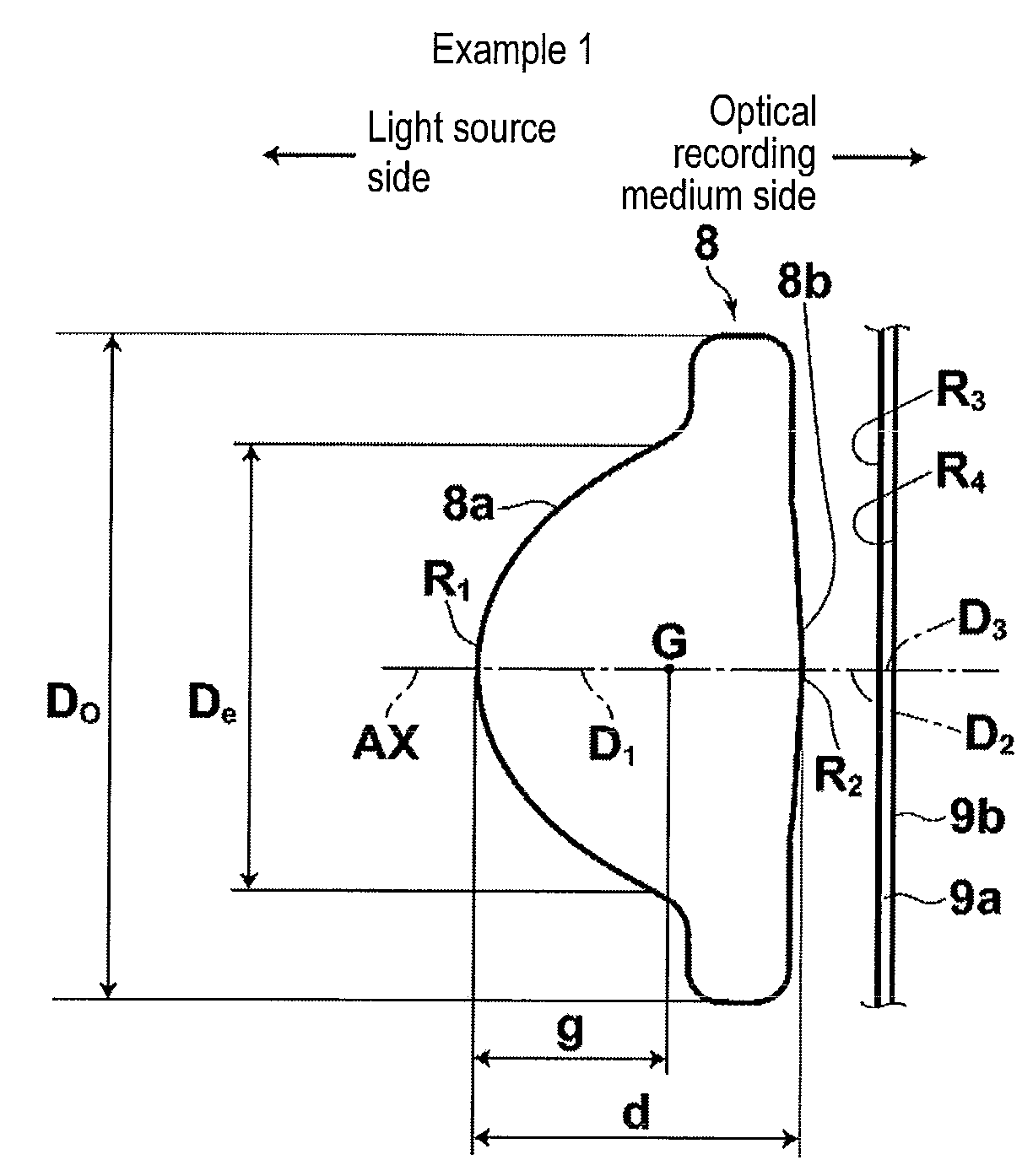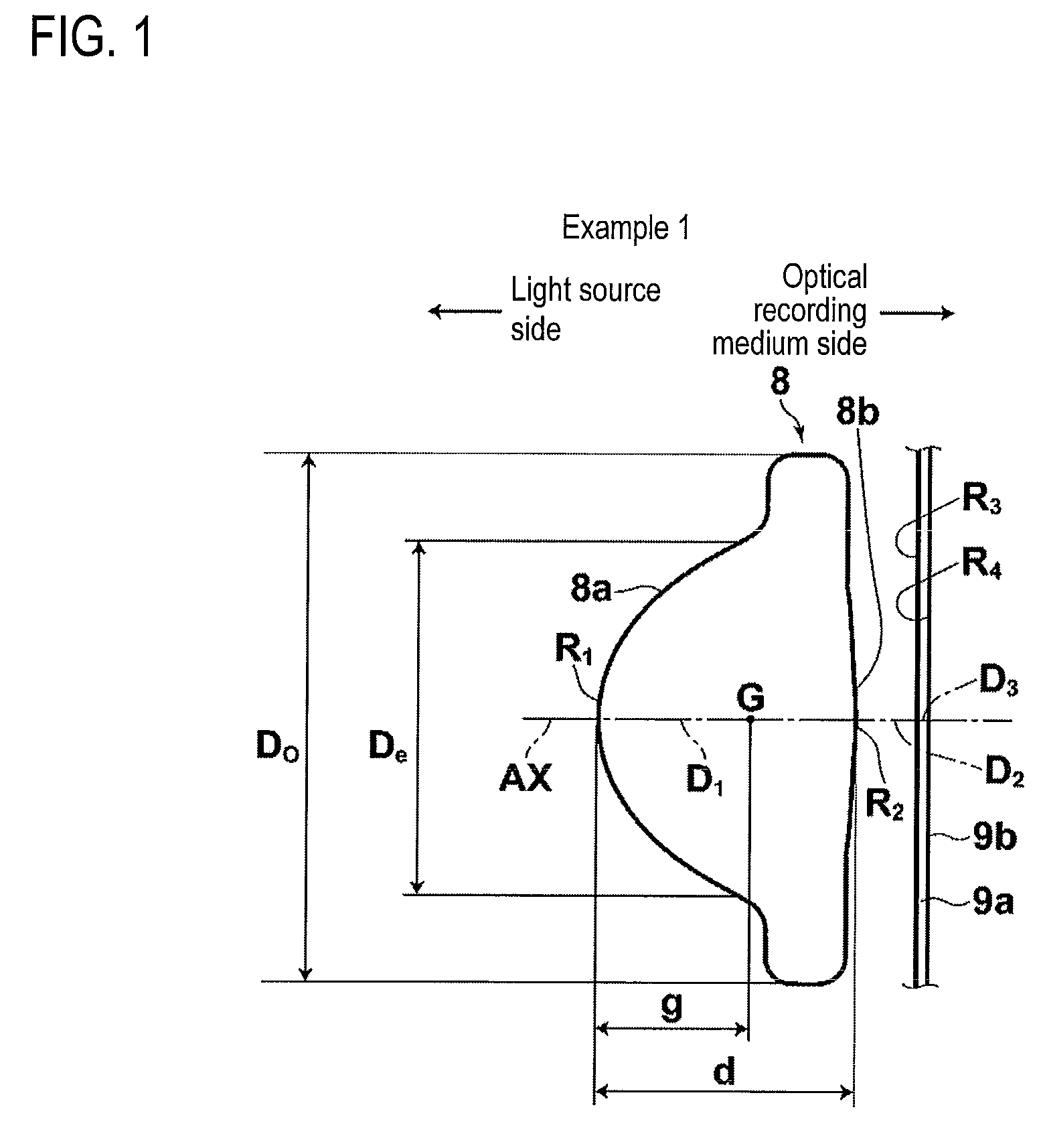Objective lens, optical pickup device, and optical recording/reproducing apparatus
a technology of optical pickup and optical recording, applied in the field of optical recording/reproducing apparatus, can solve the problems of difficult to achieve sufficient optical efficiency in practice, difficult to secure working distance, and difficult to satisfy this demand by promoting a decrease in wavelength, so as to reduce the weight of the lens, and improve the effect of focusing and tracking control
- Summary
- Abstract
- Description
- Claims
- Application Information
AI Technical Summary
Benefits of technology
Problems solved by technology
Method used
Image
Examples
example 1
[0108]The objective lens 8 according to Example 1 is formed of a single lens made of glass. As shown in FIG. 1, the light source side surface 8a and the optical recording medium side surface 8b are convex surfaces near the optical axis, and the light source side surface 8a is the convex surface having a larger curvature than the optical recording medium side surface 8b. Furthermore, both the surfaces of the objective lens 8 according to this example are aspheric surfaces each of which is rotationally symmetric.
[0109]In the upper part of the following Table 1, surface numbers are assigned so as to sequentially increase as it gets closer to the optical recording medium side from the light source side when the light source side surface is numbered as 1. The upper part thereof also shows the following items as lens data of the objective lens 8 according to Example 1: radiuses of curvature R (mm) of surfaces; on-axis surface spacings D (mm); and refractive indices N at a wavelength of th...
example 2
[0114]The objective lens 8 according to Example 2 is formed of a single lens made of glass. As shown in FIG. 2, the light source side surface 8a and the optical recording medium side surface 8b are convex surfaces near the optical axis, and the light source side surface 8a is the convex surface having a larger curvature than the optical recording medium side surface 8b. Furthermore, both the surfaces of the objective lens 8 according to this example are aspheric surfaces each of which is rotationally symmetric.
[0115]As for data according to Example 2, the upper part of the following Table 2 shows lens data, the middle part thereof shows aspheric surface data, and the lower part thereof shows various data.
TABLE 2Example 2Radius ofcurvature RSurface spacingRefractiveSurface(mm)D (mm)index N1Aspheric1.4471.6052Aspheric0.3371.0003∞0.10001.6194∞1st surface2nd surfaceC1.211757025−0.569673325K2.231072347E−019.067227885E−01A46.679499460E−021.623953466E+00A67.115742222E−02−6.252104914E+00A8−...
example 3
[0118]The objective lens 8 according to Example 3 is formed of a single lens made of plastic. As shown in FIG. 3, the light source side surface 8a and the optical recording medium side surface 8b are convex surfaces near the optical axis, and the light source side surface 8a is the convex surface having a larger curvature than the optical recording medium side surface 8b. Furthermore, both the surfaces of the objective lens 8 according to this example are aspheric surfaces each of which is rotationally symmetric. Furthermore, the optical recording medium side surface of the objective lens 8 of this example is formed in a convex shape near the optical axis and is formed in a concave shape at a predetermined position distant from the optical axis AX.
[0119]As for data according to Example 3, the upper part of the following Table 3 shows lens data, the middle part thereof shows aspheric surface data, and the lower part thereof shows various data.
TABLE 3Example 3Radius ofcurvature RSurfa...
PUM
| Property | Measurement | Unit |
|---|---|---|
| mass | aaaaa | aaaaa |
| wavelength | aaaaa | aaaaa |
| wavelength | aaaaa | aaaaa |
Abstract
Description
Claims
Application Information
 Login to View More
Login to View More - R&D
- Intellectual Property
- Life Sciences
- Materials
- Tech Scout
- Unparalleled Data Quality
- Higher Quality Content
- 60% Fewer Hallucinations
Browse by: Latest US Patents, China's latest patents, Technical Efficacy Thesaurus, Application Domain, Technology Topic, Popular Technical Reports.
© 2025 PatSnap. All rights reserved.Legal|Privacy policy|Modern Slavery Act Transparency Statement|Sitemap|About US| Contact US: help@patsnap.com



